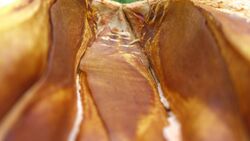Biology:Toona calantas
| Toona calantas | |
|---|---|

| |
| Seeds of the Toona calantas, still contained in a capsule. | |
| Scientific classification | |
| Kingdom: | Plantae |
| Clade: | Tracheophytes |
| Clade: | Angiosperms |
| Clade: | Eudicots |
| Clade: | Rosids |
| Order: | Sapindales |
| Family: | Meliaceae |
| Genus: | Toona |
| Species: | T. calantas
|
| Binomial name | |
| Toona calantas Merr. & Rolfe
| |
Toona calantas is a species of tree in the mahogany family. It is found in Indonesia, the Philippines , and Thailand. It is threatened by habitat loss.[1] It is commonly known as kalantas (also spelled calantas), lanipga (in Visayan and Bikol),[2] ample (in Batanes),[2] bantinan (in Cagayan and Mountain Province),[2] danupra (in Zambales and Ilocos Norte),[2] Philippine cedar, or Philippine mahogany (although the latter is also applied to members of the unrelated genus Shorea).[3]
Description and phenology
The kalantas tree can grow up to 25 metres (82 ft) and can measure up to 25 centimetres (9.8 in) in diameter.[4] The color of the bark ranges from yellowish to dark brown and the inner bark is light brown[2] while trunk is straight and terete.[4] The leaves can be described as compound, alternate oblong or broadly lanceolate[clarification needed].[4] The fruit of the kalantas tree is a capsule that can be ellipsoid or oblongoid that measures 3–4 centimetres (1.2–1.6 in) long.[2]
Flowering occurs from June to August while fruiting occurs from September to November.[5] In Mount Makiling, Laguna, Philippines, seed gathering takes place from February to March.[5]
Distribution, importance and conservation status
Generally scattered all over the Philippines particularly in the Balabac group of islands, the kalantas tree can be found in the hills of a forest situated in low to medium altitudes.[4] The wood of the tree is used for making boxes, furniture or plywood.[4][5] Kalantas has been categorized by the International Union for Conservation of Nature (IUCN) as Data Deficient[2] but it was reported that kalantas is exhausted due to logging and kaingin (a Tagalog term for slash-and-burn).[4] Reforestation efforts have been done in the Philippines and the kalantas tree is included in these efforts.[6] One of the efforts were done by the Philippine Department of Environment and Natural Resources during the term of then President Gloria Macapagal-Arroyo where the president herself planted a seedling of a kalantas tree,[7] which is the favored tree promoted by the president.[8]
Gallery
References
- ↑ 1.0 1.1 Barstow, M. (2018). "Toona calantas". IUCN Red List of Threatened Species 2018: e.T32122A68105077. doi:10.2305/IUCN.UK.2018-1.RLTS.T32122A68105077.en. https://www.iucnredlist.org/species/32122/68105077. Retrieved 17 November 2021.
- ↑ 2.0 2.1 2.2 2.3 2.4 2.5 2.6 "Kalantas" (in en). https://binhi.ph/tree/kalantas/.
- ↑ ASEAN Tropical Plant Database. "Toona calantas Merr. & Rolfe". National Institute of Environmental Research, Republic of Korea. Archived from the original on December 11, 2013. https://archive.today/20131211195714/http://211.114.21.20/tropicalplant/html/print.jsp?rno=193. Retrieved December 12, 2013.
- ↑ 4.0 4.1 4.2 4.3 4.4 4.5 "Kalantas" (in en). 2013-09-25. https://caintaplantnursery.com/our-products/philippine-indigenous-plants/kalantas/.
- ↑ 5.0 5.1 5.2 Dayan, Maria dP.; Reaviles, Rosalinda S.; Bandian, Dolora B. (August 2007). "DENR Recommends Volume 15b INDIGENOUS FOREST TREE SPECIES IN LAGUNA PROVINCE". http://www.rainforestation.ph/resources/pdf/publications/Dayan_et_al_2007_Indigenous_Forest_Tree_Species_in_Laguna_Province.pdf.
- ↑ "Mining firm achieves high reforestation survival rate" (in en). Philippine Daily Inquirer. 2019-06-26. https://business.inquirer.net/273290/mining-firm-achieves-high-reforestation-survival-rate.
- ↑ "PGMA declares La Mesa Dam as a protected watershed". Presidential Communications Operations Office. 2007-07-18. https://pcoo.gov.ph/wp-content/uploads/News%20Releases/2007/jul18.htm.
- ↑ Codamon, Dan B. (2007-07-23). "PIA daily news in English, Tagalog, Cebuano, Hiligaynon, Ilocano, Waray, Pangalatok from around the Philippines". Philippine Information Agency. http://archives.pia.gov.ph/?m=12&sec=reader&fi=p070723.htm&no=32.
Wikidata ☰ Q5504141 entry
 |






